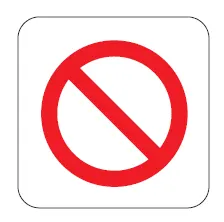Prohibited sign
-
 CDE
CDE - Update on. 23 Apr, 2025

Introduction
In Canadian road signage, prohibitory signs play a crucial role in regulating driver behavior and ensuring safety. One of the most recognizable is the General Prohibition Sign—a red circle with a diagonal line through it. Understanding this sign is essential for all drivers, especially those studying for the Ontario G1 test.
What Does the Prohibited Sign Mean?
This sign is a universal symbol for “No” or “Prohibited”. While it appears plain at first glance, it serves as a base for multiple specific prohibitory signs. When placed over an icon (e.g., a bicycle, horn, or U-turn), it indicates that the depicted action is not allowed.
The red circle and slash emphasize restriction, while the white background ensures high visibility and contrast.
Where Are Prohibited Signs Typically Placed?
This sign—either by itself or over a specific icon—is commonly placed in areas where certain actions are forbidden. Common locations include:
-
No Parking or No Stopping zones
-
Restricted areas like private property or school zones
-
Construction zones or sensitive areas
-
Near hospitals or quiet zones (e.g., No Honking)
-
One-way roads (e.g., No Entry)
Placement follows standards set in the Ontario Traffic Manual (OTM) and local bylaws to reduce confusion and ensure road order.
How Should Drivers Respond to the Prohibited Sign?
When drivers see this sign, they should:
-
Look carefully at the icon inside the circle to understand what is prohibited
-
Immediately comply with the restriction to avoid penalties
-
Be extra cautious in areas with multiple prohibitory signs
-
Never ignore or override the prohibition, even if the road appears clear
Ignoring prohibition signs can result in:
-
Traffic tickets and fines
-
Vehicle towing or immobilization
-
Demerit points on your driving record
Visual Representation of the Sign
This sign features a bold red circle with a diagonal slash on a white square background. When used alone, it’s typically shown in educational materials to illustrate the concept of prohibition. On actual roads, it’s combined with symbols representing forbidden actions.
Conclusion
The General Prohibition Sign is a foundational element of Canadian road safety signage. It teaches drivers to recognize and respect restrictions, contributing to safer, more orderly traffic. Whether it prohibits parking, honking, or turning, this sign sends a clear message: don’t do it here. Learning its variations is essential for both passing driving tests and being a responsible driver.

Please Comment Below